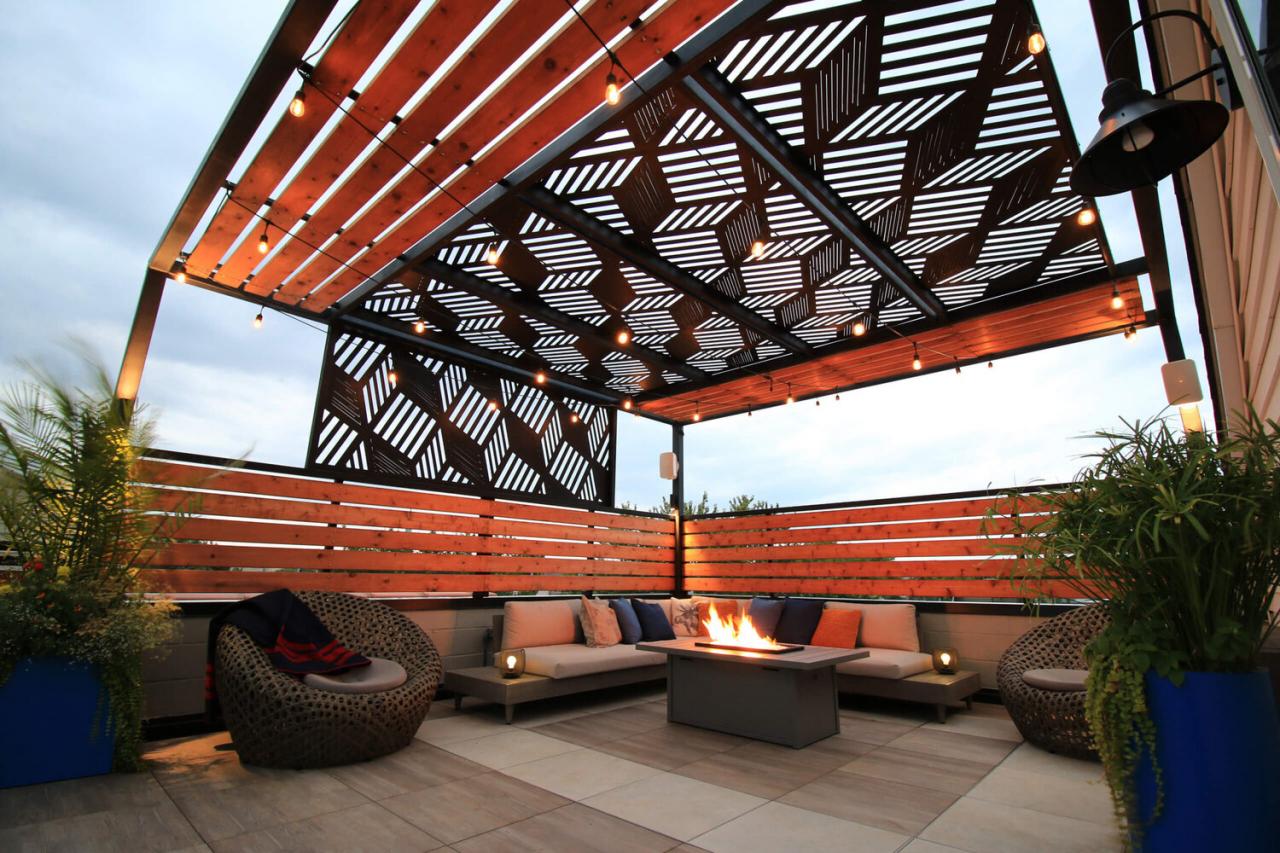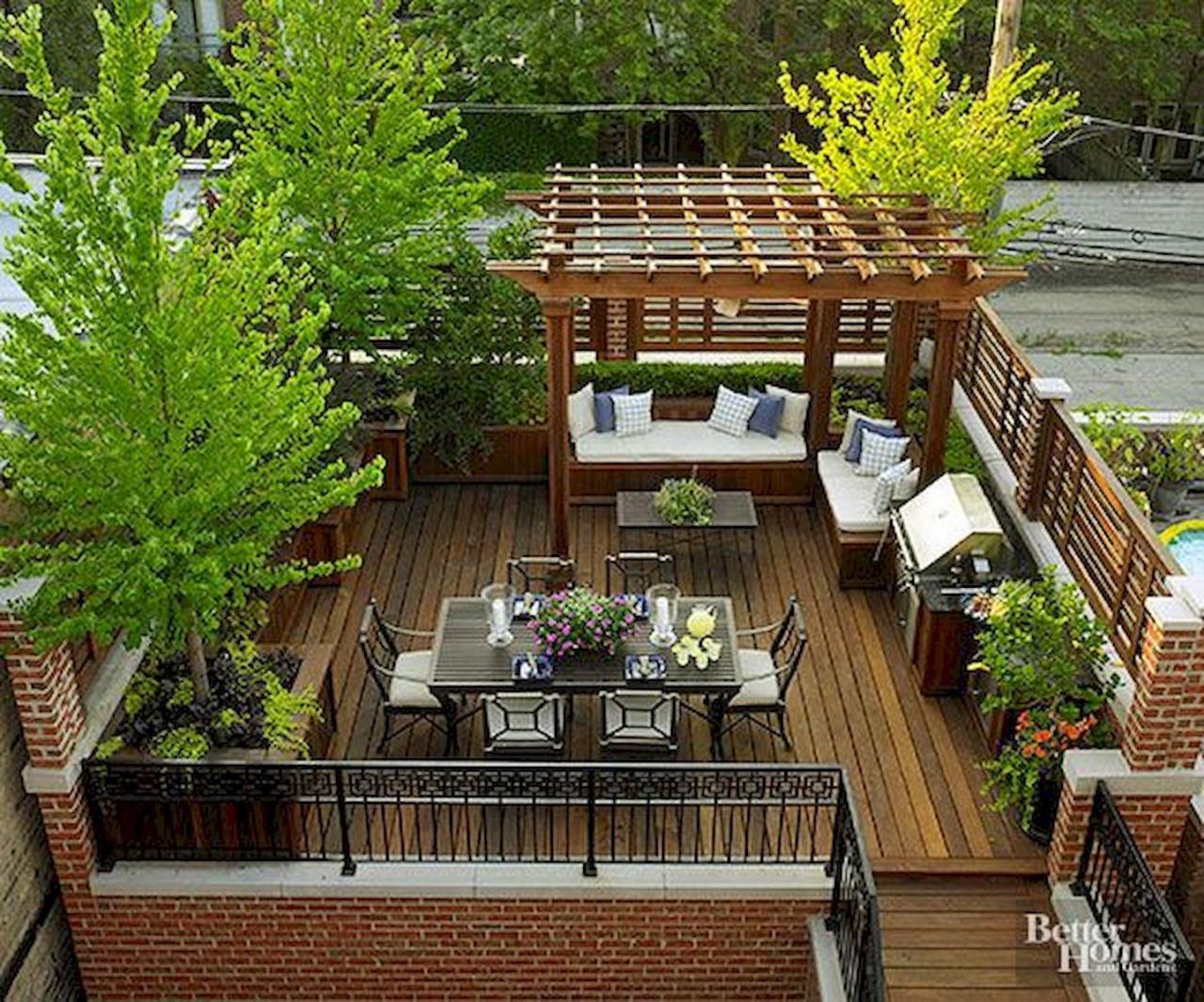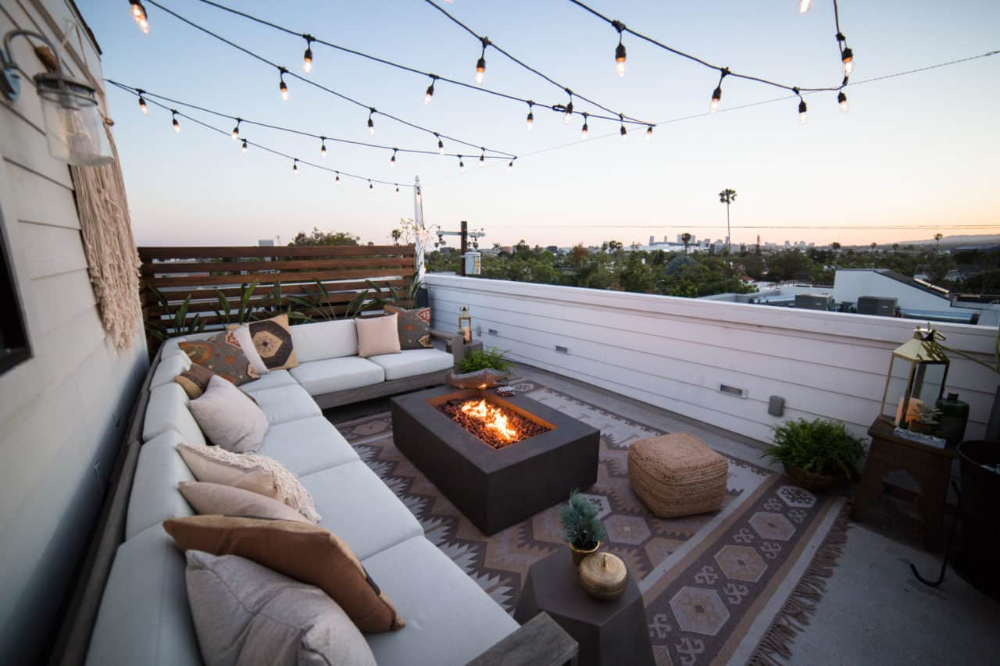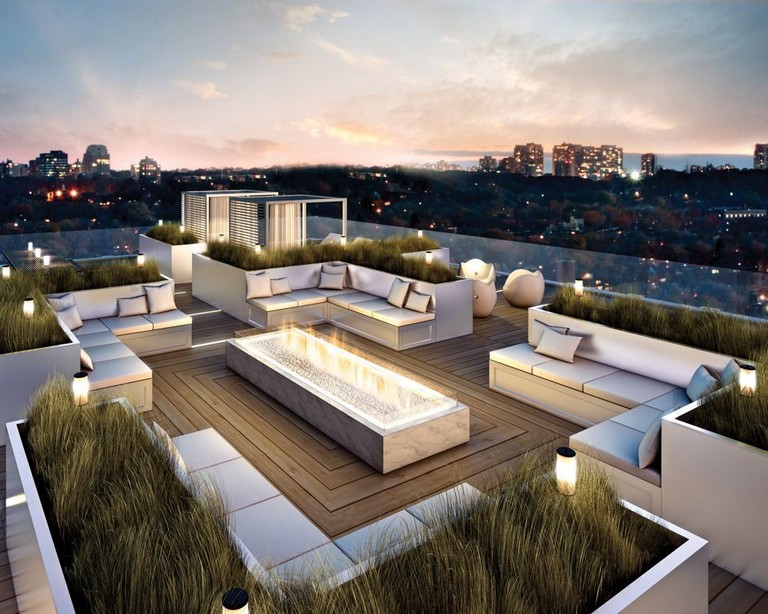Rooftop design inspiration for maximizing views and natural light: Dreaming of a breathtaking rooftop oasis? Imagine panoramic cityscapes stretching out before you, bathed in the warm glow of natural sunlight. This isn’t just a dream; it’s achievable with the right design choices. From strategically placed skylights that flood your space with light to carefully selected railing designs that enhance, not obstruct, your view, we’ll explore every aspect of creating the perfect rooftop haven.
Get ready to transform your rooftop into a stunning extension of your home, a place where you can truly connect with the outdoors and enjoy the beauty of your surroundings.
This guide delves into the key elements of rooftop design, offering practical tips and inspiring ideas to help you achieve the ultimate rooftop experience. We’ll cover everything from optimizing your layout for maximum views to harnessing natural light effectively, incorporating sustainable practices, and choosing the right materials for both aesthetics and durability. Prepare to be amazed by the possibilities!
Optimizing Rooftop Space for Views: Rooftop Design Inspiration For Maximizing Views And Natural Light

Maximizing your rooftop’s potential for breathtaking views requires careful planning and design. The orientation of your building, the surrounding landscape, and even the materials you choose all play a significant role in creating a truly stunning and functional outdoor space. This section explores key strategies for optimizing your rooftop for unparalleled views.
Rooftop Layout Options for Panoramic Views, Rooftop design inspiration for maximizing views and natural light
Strategic layout is paramount to maximizing views. Different building orientations and surrounding landscapes demand unique approaches. Consider the following options, carefully weighing the pros and cons to determine the best fit for your specific rooftop.
| Layout | Pros | Cons | View Optimization Strategy |
|---|---|---|---|
| Open-Plan with Central Seating Area | Provides unobstructed views from multiple points, promotes social interaction. | Can feel exposed to the elements, less privacy. | Place seating strategically to capitalize on the best view angles; consider retractable awnings for sun protection and privacy. |
| Partitioned Areas with Defined Zones | Offers greater privacy and functionality; allows for dedicated dining, lounging, and gardening areas. | May partially obstruct views depending on partition design and placement. | Use transparent or low partitions; strategically place taller elements to frame key views while maintaining separation. |
| Linear Layout with Walkway and Viewing Platform | Ideal for long, narrow rooftops; creates a sense of journey and discovery as you move along the space. | Limited space for large furniture or multiple activities. | Maximize the viewing platform’s position for optimal panorama; utilize the walkway strategically to direct the eye to key viewpoints. |
| Layered Design with Varying Heights | Creates visual interest and allows for both intimate seating areas and broader viewing platforms. | Requires careful planning and construction; can be more expensive. | Use varying heights to frame views and create focal points; incorporate different levels of seating to maximize view access. |
Impact of Railing Designs on Views and Aesthetics
Railings are essential for safety, but their design significantly impacts both view obstruction and the overall aesthetic appeal of the rooftop. Consider these options:
Glass Railings: These offer nearly unobstructed views, maximizing the panoramic effect. The sleek, modern aesthetic complements various design styles. However, they can be more expensive and require regular cleaning to maintain transparency.
Metal Railings: Metal railings, such as stainless steel or wrought iron, offer durability and a range of design options, from minimalist to ornate. The level of view obstruction depends on the design; thinner profiles minimize visual impact.
Cable Railings: These utilize stainless steel cables stretched between posts, providing a modern and minimalist look with minimal visual obstruction. They offer a clean, uncluttered appearance while maintaining safety.
Wood Railings: Wood railings provide a warmer, more natural feel. However, they can obstruct views more than other options and require regular maintenance to prevent weathering and deterioration. The design can be customized to complement the overall style of the rooftop.
Dreaming of a rooftop design that maximizes stunning views and natural light? Consider the impact of strategic placement of windows and glass panels to amplify the effect. For a taste of sophisticated rooftop ambiance, check out the rh marin rooftop menu – their design aesthetic offers some serious inspiration for creating a breathtaking space. Ultimately, your rooftop design should seamlessly blend indoor and outdoor living, maximizing the beauty of your surroundings.
Rooftop Decking Materials and Their Influence on Views
The choice of decking material affects both the visual appeal and durability of your rooftop.
Dreaming of breathtaking rooftop views? Maximizing natural light and panoramic vistas in your rooftop design is key to creating an amazing space. For some seriously inspiring design ideas, check out the stunning ambiance and perhaps even the menu at the rh rooftop menu jacksonville – it’s a great example of how thoughtful design can elevate an outdoor space.
Then, translate that inspiration into your own rooftop haven, ensuring every detail maximizes the incredible views and natural light.
Wood Decking: Natural wood offers warmth and texture, creating a visually appealing and inviting space. However, it requires regular maintenance, including sealing and staining, to protect it from the elements. The color and grain of the wood can subtly influence the overall aesthetic, potentially complementing or contrasting with the surrounding landscape.
Composite Decking: Composite decking materials mimic the look of wood but require less maintenance. They are durable and resistant to rot, fading, and insect damage. The color choices are usually limited, and the texture may not be as natural as real wood.
Concrete Decking: Concrete offers exceptional durability and requires minimal maintenance. It’s a versatile material that can be stained or textured to create a variety of looks. However, it can feel less inviting than wood or composite materials, and its color and texture may not always enhance the views.
Stone Decking: Natural stone provides a luxurious and elegant feel. It’s durable and weather-resistant but can be expensive and heavy. The natural variations in color and texture can create a unique visual appeal that complements the surrounding landscape.
Harnessing Natural Light on Rooftops

Maximizing natural light on a rooftop not only reduces energy consumption but also enhances the overall ambiance and livability of the space. Strategic window placement and material selection are crucial for effectively harnessing the sun’s energy while minimizing unwanted heat and glare. This section explores various window types and design considerations for optimal natural light utilization.
Skylight Effectiveness and Placement
Skylights are a popular choice for introducing natural light into rooftop spaces. Their effectiveness depends heavily on size, placement, and design. Larger skylights naturally admit more light, but careful consideration must be given to potential heat gain and glare. Dome-shaped skylights, for example, tend to diffuse light more effectively than flat skylights, reducing glare. Placement is crucial; positioning skylights away from direct sunlight during peak hours minimizes heat build-up.
Imagine a rooftop garden design: strategically placed skylights above seating areas would provide ample natural light without causing direct glare into the eyes. Conversely, in a rooftop terrace design, skylights positioned to illuminate walkways and less-used areas would be more practical. Optimal placement often involves considering the sun’s path throughout the day to maximize beneficial light while minimizing undesirable effects.
For instance, in a northern hemisphere climate, south-facing skylights will generally provide more light throughout the year. Employing diffused glass or specialized coatings can further reduce glare and heat transmission.
Clerestory Windows and Retractable Roof Sections
Clerestory windows, positioned high on the walls of a rooftop structure, are another excellent option for maximizing natural light. Their elevated position minimizes direct sunlight, reducing glare while still allowing substantial light penetration. They are particularly effective in rooms with low ceilings, where skylights might not be feasible. Imagine a rooftop office space; clerestory windows along the perimeter would flood the space with soft, natural light, improving productivity and creating a more pleasant working environment.
Retractable roof sections offer the ultimate in natural light control. These motorized or manually operated sections allow for complete control over light and ventilation, providing maximum flexibility. Imagine a rooftop entertainment area; opening these sections on a clear day would transform the space, creating an open-air feel and bringing in ample natural light and fresh air.
Roof Color and Material Impact on Natural Light
The choice of roof color and material significantly impacts how much natural light is reflected or absorbed. This selection should consider both aesthetic and functional aspects.
- Light-colored roofs (white, light gray): Reflect a significant portion of sunlight, reducing heat absorption and keeping the interior cooler. This leads to lower energy consumption for cooling. A white roof, for example, can significantly reduce the urban heat island effect.
- Dark-colored roofs (black, dark gray, brown): Absorb a greater amount of sunlight, leading to increased heat absorption and potentially higher energy costs for cooling. However, they can also offer a more dramatic aesthetic appeal.
- Reflective roofing materials (e.g., metal with reflective coating): These materials are specifically designed to reflect sunlight, minimizing heat gain and maintaining a cooler interior. They can contribute to energy savings and improved sustainability.
- Materials with high solar reflectance index (SRI): The SRI value indicates how effectively a roofing material reflects solar radiation. Higher SRI values mean better heat reflection and reduced energy consumption. Choosing materials with a high SRI is crucial for energy efficiency.
Rooftop Design Elements for Enhanced Views and Light

Transforming a rooftop into a stunning and functional space requires careful consideration of design elements that maximize both views and natural light. This involves strategic placement of structures, thoughtful plant selection, and clever integration of artificial lighting to complement the natural environment. Let’s explore some key elements to achieve this.
Pergola Design for Shade and View Maximization
A well-designed pergola can significantly enhance a rooftop’s usability while preserving unobstructed views. Consider a pergola with a lightweight, open design, perhaps constructed from powder-coated aluminum or treated timber for durability. The structure should be positioned to provide shade during peak sun hours while minimizing its impact on the panoramic views. Imagine a pergola with a gently sloping, slatted roof, allowing dappled sunlight to filter through while preventing harsh direct rays.
The slats could be adjustable, offering control over shade intensity. To further enhance the visual appeal and integration with the surrounding space, climbing plants like bougainvillea or jasmine could be trained to grow along the pergola’s structure, adding a touch of vibrant color and natural texture. This design would create a beautiful and functional shaded area without sacrificing the breathtaking rooftop vista.
Rooftop Garden Design for Visual Appeal and Light Management
The selection of plants for a rooftop garden is crucial for both aesthetic enhancement and light management. Prioritize plants with varying heights and textures to create visual interest and depth. Taller plants, such as bamboo or certain varieties of ornamental grasses, can act as windbreaks and provide privacy, while smaller flowering plants can add splashes of color. To manage natural light, incorporate plants with different light requirements.
Shade-tolerant plants, like hostas or ferns, can be placed in areas receiving less direct sunlight, while sun-loving plants, such as succulents or lavender, can thrive in sunnier spots. Consider using a mix of deciduous and evergreen plants to ensure year-round visual interest and varied levels of shade throughout the seasons. For example, a combination of flowering shrubs like hydrangeas and evergreen groundcovers like creeping thyme could create a visually appealing and functional rooftop garden that complements the existing landscape and enhances the space’s natural light balance.
Outdoor Lighting Plan for Nighttime Enhancement
Strategic outdoor lighting is essential for transforming a rooftop into a magical space at night. Avoid harsh, direct lighting; instead, opt for softer, ambient illumination that complements the natural environment and enhances the nighttime views. Consider using low-voltage LED lighting embedded in the pergola structure or along pathways, casting a warm, inviting glow. Uplighting could be used to highlight architectural features or accentuate the beauty of the plants.
For example, strategically placed spotlights could subtly illuminate the foliage, creating a dramatic and enchanting effect. String lights, draped across the pergola or along the rooftop perimeter, can add a touch of whimsical charm. The overall lighting scheme should aim for a balance between functionality and atmosphere, creating a comfortable and visually stunning space for nighttime enjoyment.
This carefully planned lighting design would not only enhance the nighttime views but also contribute to a relaxing and inviting atmosphere on the rooftop.
Integrating Sustainable Design Principles

Sustainable rooftop design isn’t just about aesthetics; it’s about creating environmentally responsible spaces that enhance both the building and its surroundings. By incorporating green technologies and eco-friendly materials, we can maximize natural light, improve thermal performance, and create stunning views while minimizing our environmental footprint. This approach offers a holistic solution, blending functionality with sustainability.
Green Roofing and its Impact on Light, Thermal Performance, and Views
Green roofs, also known as living roofs, significantly impact a building’s energy efficiency and aesthetic appeal. The vegetation acts as natural insulation, reducing heating and cooling costs while improving air quality. Different green roof systems offer varying levels of light transmission and thermal performance, affecting the overall view and interior environment.
| Green Roof Type | Light Transmission | Thermal Performance | View Enhancement |
|---|---|---|---|
| Extensive Green Roof (Shallow) | Low to Moderate; depends on plant selection and density. Taller plants will reduce transmission more. | Excellent insulation, reducing heat gain in summer and heat loss in winter. | Adds a layer of green, softening hard lines and improving the overall visual appeal from below and potentially from adjacent buildings. Views from the roof itself might be partially obscured depending on plant height. |
| Intensive Green Roof (Deep) | Low; significant reduction due to thicker vegetation and soil layers. | Superior insulation compared to extensive roofs; can support a wider variety of plants and even small trees. | Creates a lush, park-like environment on the rooftop, offering significant visual interest but potentially obscuring distant views. |
| Hybrid Green Roof | Moderate; a balance between extensive and intensive systems, allowing for customization. | Good insulation; offers flexibility in plant selection and depth to optimize both thermal performance and visual impact. | Offers a compromise between view obstruction and green space; careful plant selection is key to maximizing both. |
| Brown Roof (Gravel/Sedum) | Moderate to High; gravel allows for greater light penetration. | Good insulation, especially compared to a bare roof; however, less effective than green roofs with soil and vegetation. | Offers a simpler, more minimalist aesthetic compared to green roofs; views are less obstructed. |
Solar Panel Integration Strategies
Integrating solar panels without sacrificing views or natural light requires careful planning and innovative design. Several strategies can achieve this balance:
Building-Integrated Photovoltaics (BIPV): BIPV systems seamlessly integrate solar panels into the building’s design, acting as roofing materials, façade elements, or even skylights. This approach minimizes visual impact and can even enhance the building’s aesthetics. Examples include solar shingles that mimic traditional roofing tiles or transparent solar panels integrated into windows, allowing light to pass through while generating electricity.
Roof-Mounted Solar Panel Arrays with Optimized Placement: Strategic placement of solar panels is crucial. Panels can be arranged to maximize sunlight capture while minimizing shading on windows or other areas requiring natural light. This might involve using a south-facing roof (in the Northern Hemisphere) or adjusting panel angles to optimize sun exposure throughout the day. The use of smaller, lighter panels can make installation easier and more adaptable to existing rooftop designs.
Solar Panel Integration with Green Roofs: Combining solar panels with green roofs is possible. The panels can be mounted on a framework above the green roof, allowing for both energy generation and the benefits of a living roof. Careful consideration is needed to ensure proper ventilation and water drainage for the green roof. This method could be used with extensive green roofs to avoid significant reduction in light transmission.
Sustainable Materials for Rooftop Construction
Choosing sustainable materials reduces the environmental impact of rooftop construction while maximizing views and light. These materials often have a longer lifespan, requiring less maintenance and replacement over time.
- Recycled Materials: Using recycled steel, aluminum, or plastic in structural elements or cladding minimizes waste and reduces reliance on virgin resources.
- Locally Sourced Materials: Selecting materials from local sources reduces transportation costs and emissions, promoting regional economies.
- Bamboo: A rapidly renewable resource, bamboo offers excellent strength and flexibility, suitable for various structural and decorative applications.
- Reclaimed Wood: Giving new life to reclaimed wood reduces deforestation and offers unique aesthetic qualities.
- Sustainable Concrete: Utilizing concrete with lower embodied carbon or incorporating recycled materials in its production reduces its environmental impact.
- Lightweight Roofing Systems: Reducing the overall weight of the roof minimizes structural requirements, leading to potential material savings and reduced environmental impact.